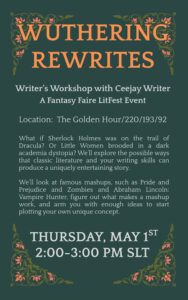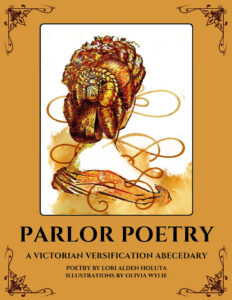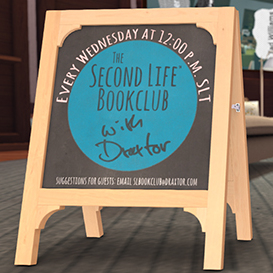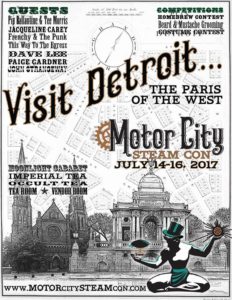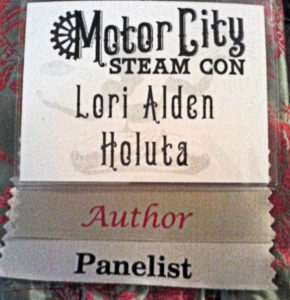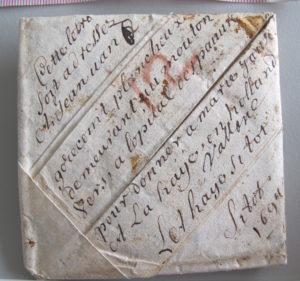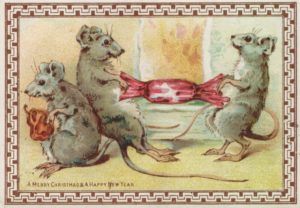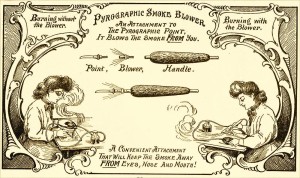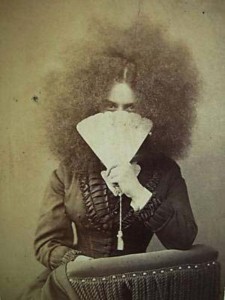I wanted to share the notes that I used at AnomalyCon 2016 in Denver, Colorado during my featured hour. Remember, this isn’t meant to be a formal article. It’s a collection of information. If you find something in particular you’d like to know more about, I encourage you to hit google and I’m betting you will find dozens of articles on anything mentioned here. I did!
The Mad Science of Victorian Cooking
Lori Alden Holuta
Cooking is science, and the Victorians obsessed with alchemy–and here the two combine, perhaps with dangerous results!
The Victorian Era was an amazing time to be a Foodie! Many changes in American eating habits developed as the citizens got settled in and stopped moving around so much. As home life became more stable, we demanded much more from our kitchens. We wanted better food, faster, easier, and reliable ways to store it.
One of my favorite foodies of the day was Fannie Farmer. She graduated from one of the first American cooking schools, The Boston Cooking School, and in 1896 published (at her own expense) the Boston Cooking-School Cookbook. Versions of her book are still in use today.
Thanks in great part to Fannie, our recipes became more exact. She removed the guesswork from recipes and helped standardize the American measurement system. Precise measurements came into use instead of ‘pinches’ and ‘butter the size of an egg’. She earned the nickname “The Mother of Level Measurements”. Explicit instructions were a huge boon to novice cooks, as it takes many years to develop a natural sense of ‘when just enough is right.’
But, it’s no good having well-prepared food if it’s not safe to eat! We owe a debt of thanks to Louis Pasteur, who in 1856 figured out how to make food much safer. His process of Pasteurization kills bacteria in certain foods.
In 1859 Louis Pasteur entered a contest sponsored by the French Academy of Sciences. The goal was to devise an experiment that would disprove the belief in “spontaneous generation’. What, you may ask, is spontaneous generation? It was a longstanding belief that dated back to before the middle ages. Basically, people believed that decaying matter could suddenly produce life forms.
Here’s a spontaneous regeneration recipe from the 17th century, and I swear I am not making this up! How to produce mice: Put your sweaty stinky underwear into a jar, add wheat husks and wait three weeks. During that time, the sweat would soak into the husks and turn them into mice. Knowing all we know today, of course that was absurd thinking. Mice were sneaking in after those wheat husks, of course. But this is the sort of mindset that needed to be shattered.
Anyway, Pasteur’s contest experiment had him boiling meat broth in a flask, then heating the neck of the flask enough to bend it into an S shape. The S allowed air to enter, but microorganisms settled out in the S curve, thanks to gravity. The broth did not produce any microorganisms – and when he tilted the flask to let the broth slide up into the S where all the icky stuff had settled, THEN the broth turned cloudy and went awful.
This new information about the effects of air and microorganisms on food helped pave the way for advances in food storage techniques.
The notion of putting food into metal cans has been around a long time. Decades before Pasteur changed the way we thought about food safety, we’d starting sealing food into containers. In 1810. Peter Durand figured out how to put food into cans.
His invention went into use the British Navy a few years later. Sounds good so far, right? Well. The cans were made of solid iron with a thin coating of tin that clearly outweighed their contents. Now, let’s assume you’re hungry and you’d actually like to get AT those contents.
Grab a can opener? Nope. They haven’t been invented yet and won’t be for a long time. The recommended method to get at your ironclad foodstuffs was to get a hammer and chisel and work your way around the top. Some people couldn’t be bothered with that method and used bullets or bayonets to try to get at their supper.
Any nutritional benefits of the canned food was surely offset by the risk of injury from the method of opening, or the metal shards that might get bashed into your food and ingested… clearly, the food can was an idea needing a lot of work.
In the 1860’s, steel cans replaced those old iron ones – and hurrah, they were much thinner! In 1858, Ezra Warner was the first to obtain a patent on a can opener (clearly, he’d been waiting for this advancement in canning technology). His can opener had a blade that could be shoved into the rim of the can and then forced around the edge. Warner claimed in his patent that‘“a child may use it without difficulty, or risk.”
But you wouldn’t find Ezra’s can opener anywhere in a kitchen – when you purchased your canned goods, you’d ask the store clerk to open them for you, using the store’s can opener. And then you’d take them home. Any benefit of long-term storage ended the moment you bought your food. In 1870, William Lyman invented that handy little cutting wheel that goes around a can’s rim, and eventually the contraption settled out into something that became a must-have in every kitchen.
While tin cans are one method of long-term food storage, a more hands-on approach is home canning, which in spite of the name, uses glass jars and not cans. Home-canning techniques have changed vastly through the years, but the benefits have always been clear – growing your own food, when possible, extends the household budget, and allows you to preserve your harvest for the winter months.
Even those who don’t grow produce can benefit from taking advantage of good prices for seasonal fresh vegetables and fruit. It’s also a chance to prepare extra luxuries such as jams, jellies, relishes, and pickles. Unlike tin cans, glass jars are re-usable and the contents can be seen through the container.
Amanda Jones was a scientist who invented the vacuum method of canning. Basically, that means sucking all the air out of a container, thus making it impossible for bacteria to grow. She got the idea from her spirit guides. Yes, you heard me right. You see, she’d contacted her brother *after* his death years before, and ever since then she took most of her advice from her ‘spirit guides’.
The spirits suggested she contact a man named Cooley, and they also described to her the vacuum canning process. She’d never canned anything in her life, but she got in touch with Cooley, and in 1873, together they created the “Jones Process”.
Ten years later, she founded the Women’s Canning and Preserving Company, only allowing women to work there. But three years later, men were hired – and they promptly took over the company and tossed Amanda out. Bet the spirits didn’t tell her *that* was coming!
Now let’s move on to some fun devices that help us make our food tasty. How many of you like…. toast? It’s one of my favorite snacks! People have been making toast for eons. It was originally a way to preserve bread once it lost it’s fresh-baked texture. It’s also a very handy communication device for sending us mere mortals images of deities and aging entertainers, lightly burned into our bread, just waiting for us to alert Ripley’s, or the Weekly World News.
In the Pre-Toaster Era, hunks of bread were laid on hot stones or held up to a fire. In fact, the word ‘toast’ is derived from the Latin ‘tostum’ which means to scorch or burn.
In England in the 1870’s, the first toasters began to appear. These were simple iron heating coils that a slice of bread could be leaned close to. The bread needed to be hand-turned to get both sides toasted. Still, it was pretty techie compared to hot rocks. But these first machines were slightly inconvenient, as they had a tendency to rust, melt, and start fires.
In later years, General Electric pioneered the use of nickel and chromium in the coils, which eliminated that tendency to melt. The toaster has undergone constant refining and improvements ever since – proof that we all are seeking the Perfect Slice of Toast. Someday, I predict that we shall even have Talking Toasters!
Who likes cake? CAKE. A light fluffy cake often requires well beaten eggs. And there was a time when eggbeaters as we know them did not exist! Cooks would instead use a ’broad-bladed knife’ or ‘clean switches, peeled and dried’ to whip those egg whites into meringue, and that was very fatiguing work!
Enter intrepid inventor Rufus M. Eastman, who in 1885 created a mixer which could be powered by water, electricity or manually. Pretty fun notion, but it didn’t catch on. The man history remembers is Willie Johnston, who one year earlier devised a beater that used a wheel and well-placed gears to spin the beater blades.
His machine was dual-action, too! It would mix eggs in one bowl and dry ingredients in another, at the same time. Bet that was fun to watch!
So. Now we’ve touched upon inventions that produce toast, and cake… two favored treats in the Steamlands. But I would be remiss if I did not make mention of a device that makes that beloved foodstuff that no Tiny can resist – Waffles!
All hail Cornelius Swarthout of Troy, New York! On August 24th, 1869, he became the first inventor to patent a waffle maker. His device was clever and practical, making good use of the stoves in use at the time.
The Swarthout Waffle Maker was designed to fit exactly into one of those round openings on a woodstove. You’d pull the stove lid out, insert the waffle iron ring, and set the waffle iron into the ring, hooking it into special grooves as shown in the picture.
To cook a waffle, you’d open up the iron, add batter, close it and let the waffle cook. After a short time, you’d turn the waffle iron in the ring to get the other side of your waffle browned.
In 1868 Underwood introduced Deviled Ham. The company collaborated with MIT to study the environment of food in cans with the goal of reducing the cost of canning while increasing the safety of canned seafood and vegetables. They discovered that some bacteria can survive in the can until the internal temperature reaches 250°, higher than canning usually went in those days. They didn’t keep this fact private though, and in 1887 shared their discovery to benefit the entire canning industry.
One of the major problems in home canning was a reliable seal for bottles. One method involved pouring wax poured into the mouth of the jar to form a plug as it cooled, or coating a metal lid with wax to form a seal. But th wax was difficult to remove, and not always reliable. Then there was the thumb screw clamp and glass lid. The jar had a cast metal wire that clamped down on a glass lid and held it tightly in the neck of the jar. These were used with round rubber gaskets to create the seal. Too much clamping could break the jar, and too little made a bad seal and food spoiled.
Finally, in 1859 tinsmith John Landis Mason, solved the problem of sealing glass jars with a metal screw-on lid and rubber ring. Home canning finally became relatively safe. Mason sold his patent rights for a few hundred dollars. Mason jars have been manufactured by the Ball Corporation ever since. He should have kept that patent,
In 1894 E. P. Scott, C. P. Chisolm and J. A. Chisolm patented a mechanical pea sheller that did the work of 1,000 laborers. It made canned peas a staple of the American diet. Automated corn shuckers and mechanical tomato peelers sped these canned vegetables onto grocery shelves nationwide. By the 1890s a workman operating a machine could produce 1,500 cans each day, and canned food was inexpensive enough to be afforded by most middle class households.
Victorians were suspicious of processed foods. Lurid reports of contaminated and adulterated foods were always appearing in the newspapers, Few foods manufactured in the late 1880s were free of additives. No one knew for sure which additives were harmful and which were benign, to say nothing of being healthy.
Pickles were colored with copper salts to make them greener.
Cayenne pepper and cheddar cheese were colored with red lead or mercury sulfide to give them a vibrant red color.
Coffee was mixed with chicory and acorns to bulk it up, and burnt sugar to darken it.
Canned green vegetables treated with copper compounds to brighten up their color.
Coal tar was in chemical dyes that were used to color foods.
“Natural” foods, without additives, didn’t always sell well because they didn’t look vibrant.
The Food and Drug act helped curb most of those awful practices, and Victorians began to trust processed foods. A lot of the products invented then are still around today.
Tabasco pepper sauce arrived in 1868, and is still made *exactly* the same way as it always has been It needs no preservatives. Germs can’t live in that stuff.
In 1869 Welch’s Grape Juice was invented by a temperance fanboy named Thomas Welch, to replace communion wine in Protestant churches.
Philadelphia Cream Cheese came along in 1872, and has nothing to do with Philadelphia. Dairyman William Lawrence made the stuff in Chester, New York, but called it that simply because Philadelphia had a good reputation for cheesemaking.
Dry oat cereal flakes were introduced in 1877 by the Quaker Mill Company. It was followed in 1884 by Cerealine Flakes, a dry cereal made from corn grits, and Kellogg’s Corn Flakes in 1896 as a diet supplement.
Dr. Pepper was sold in drug stores beginning in 1885, and Coca-Cola in 1886. Both were marketed as dietary aids. Coca-cola included cocaine (the “coca” in Coca-Cola) and caffeine in its original formula. The Pure Food laws eliminated the cocaine, but not the caffeine.
Fig Newtons were invented in 1892 by Philadelphia baker Charles Roser. They are named after the city of Newton, Mass. The taste, shape and size of the cookie has never been changed.
In 1900 Hills Bros. Coffee first used vacuum packing for its ground coffee. Removing the air from the can was intended to reduce oxidation and keep the coffee fresher.
What could be a more wholesome treat than a glass of milk and a slice of bread? In the Victorian Era, you’d probably be better off eating a random wild mushroom. You might actually survive that, and at least they were natural.
Bread bakers upped their profits by adding ingredients that were cheaper than flour to bulk up the loaves. These budget-helper fillers included plaster of Paris or chalk. Alum, which is aluminum based and nowadays used in detergent, was used to make bread appear whiter and denser. It also cause malnutrition and wreaked havoc on digestive tracts, especially for children.
In 1882, about 1/5th of the milk in US households contained Boracic acid. This wasn’t just done the bottling plants, but was a popular method of “purifying” milk in households, too. Even Mrs. Beeton, the goddess of household management said it was “quite harmless” and an efficient method of making sour milk sweet again. This “quite harmless” sustenance caused nausea, vomiting and a lot of digestive woes. Not only that, the treatment didn’t alter the fact that milk often contained Bovine TB. A massive number of children died of Bovine TB in the Victorian Era.
If you survived your glass of milk, you still might succumb to Carbolic acid poisoning. Cleanliness was next to godliness and Carbolic acid was used to kill those newfangled germs. However, the containers looked a lot like other harmless products. A box of Carbolic acid looked a lot like a box of baking powder. Some of the mixup accidents were horrible. In one case, thirteen people were poisoned and five of them died.
In 1902 the Pharmacy Act made it illegal for bottles of dangerous chemicals to be similar in shape to harmless liquids.


